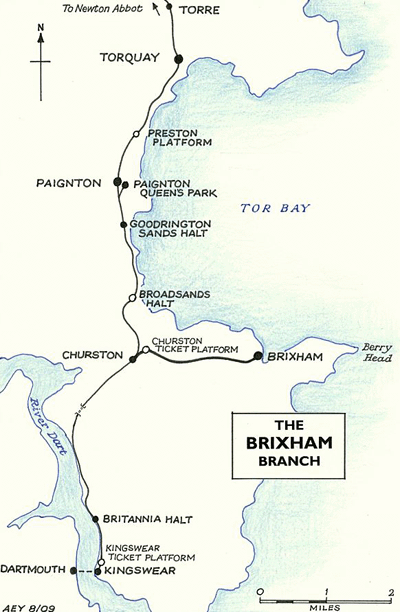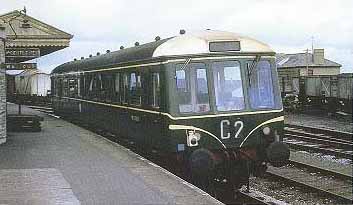Notes: Brixham Station was situated at the eastern end of a two mile branch line that connected the town of Brixham, with its busy harbour, to Churston.
 Opened on the 27th February 1868 the line was promoted and built by the Torbay and Brixham Railway Company. The company had been formed by a local Brixham solicitor Richard Wolston on the 25th July 1864. The reason for forming the company was because the Dartmouth and Torbay Railway Company, who had completed a line from Paignton to Kingswear on the 16th August 1864, had no intention of building a branch into Brixham. They provided a station at Brixham Road (renamed Churston when the Brixham branch opened), two miles away from the town, which they considered to be adequate. Richard Wolston considered a station that was situated two miles away was not at all adequate. Opened on the 27th February 1868 the line was promoted and built by the Torbay and Brixham Railway Company. The company had been formed by a local Brixham solicitor Richard Wolston on the 25th July 1864. The reason for forming the company was because the Dartmouth and Torbay Railway Company, who had completed a line from Paignton to Kingswear on the 16th August 1864, had no intention of building a branch into Brixham. They provided a station at Brixham Road (renamed Churston when the Brixham branch opened), two miles away from the town, which they considered to be adequate. Richard Wolston considered a station that was situated two miles away was not at all adequate.
The Brixham branch was laid with Broad Gauge track so that it was compatible with the Dartmouth and Torbay Railway which provided a connection to the Great Western Railway via the South Devon Railway which connected Paignton to Newton Abbot.
| Brixham Station was located high on a hill on the north side of Brixham Harbour. This elevated position was chosen in order that the gradients between Brixham and Churston were not too steep. It was provided with a single platform which had a loop so that engines could run around. The station’s building was a single storey wooden structure that was provided with a |
 |
canopy to protect passengers from the elements. Interestingly the gentlemen’s toilets which where in a separate building were constructed from brick. An engine shed was also provided at the station at the rear of the passenger platform along with goods facilities with a timber goods shed, the movement of fish caught by the towns fishing fleet being an important source of revenue. The goods yard which was controlled by a signalbox on the south side of the line on the approach to the station comprised five sidings, one serving a coal yard.
 |
Prior to opening the station was called Brixham Town but by the time the station was formerly opened on 1st January 1868 the 'Town' had been dropped. A free passenger service was provided on the opening day but inspection problems delayed public opening until 27th February 1868 with services operated by the South Devon Railway Company who also operated trains along the |
Dartmouth and Torbay Railway. Passenger services ran into Brixham Road station were passengers could connect with long distance services, including a service to London Paddington. The Brixham Branch joined the Paignton to Kingswear line via a junction that came in from the north and connected to that line facing south. This meant that Brixham trains were facing away from Paddington. A goods service to Brixham started on 1st May 1868. In 1870 Richard Wolston was declared insolvent, the cost of giving Brixham its railway having broken him financially; the railway continued to be run by other members of his family.
The first engine shed opened with the line which was worked from opening by the South Devon Railway until 1876, when the GWR took over, finally absorbing the line on 1 January 1883. By this time the shed was in poor condition so the GWR closed and removed it in 1896 and replaced it the following year with a 'second hand' shed from Stanalees on the Cornwall Mineral Railway' this was dismantles and re-erected at Brixham.
The Brixham Branch made a loss from the start which caused an argument between the Torbay and Brixham and the South Devon Railway. The result was that the Torbay and Brixham Railway took over the running of its own services. A situation that lasted until the GWR took over the branch as well as the entire line from Newton abbot to Kingswear.
| In 1892 the broad gauge line was converted to standard gauge along with all of the broad gauge lines on the GWR network. A regular shuttle service and goods service ran between Brixham and Churston. In the early part of the 20th century auto trains were introduced consisting of one or two coaches. These were to become the norm until the lines closure being |
 |
quite adequate due to the regular shuttle services that ran.
The towns of Torbay, including Brixham became very popular with holiday makers who provided the line with much needed revenue in the Summer months.
As the 20th century progressed the Brixham branch began to suffer from road competition. Bus services into Brixham were far more convenient as they delivered passengers right into the town without the need for a walk up or down a very steep hill. Even the development of two Pontins Holiday Camps did not help as passengers were bused to the camps from Churston avoiding the need to change trains.
The engine shed closed from 22nd July 1929 but the track remained in use as a siding until it was lifted in September 1959. The shed was demolished in c.1936.
 |
In 1948 the Brixham branch became part of the British Railways Western region. Little changed but the lack of traffic made the line vulnerable. After World War II. A severe cut back in train services caused by a coal shortage in 1951 halved what remained of passenger traffic and it never recovered. People simply transferred to the more convenient buses. Steam |
traction was replaced by DMU's in 1961 but the end was inevitable and in 1962 BR decided to close the line but agreed agreed to wait until after Dr Beeching's report on the viability of the whole railway network was presented in 1963.
The line closed completely on the 13th May 1963. After closure Brixham was used as the location of Roxham station in the 1964 film 'The System'. An early scene sees most of the main characters at the station, either arriving on a train hauled by a British Rail Class 22 locomotive, or waiting there to see who is arriving in the town for a holiday.The line was lifted shortly afterwards and sections of it were built over. The station site was developed as a housing estate but sections of its retaining walls can still be seen as can the ramp that led up to the platforms from Station Road.
Further reading: The Brixham Branch by CR Potts, Published by Oakwood Press 2000
ISBN 978-0-853615-56-9. Tickets from Michael Stewart
See also Churston Station |

old5.jpg)


old9.jpg)
old6.jpg)
old1.jpg)
old3.jpg)

 Opened on the 27th February 1868 the line was promoted and built by the Torbay and Brixham Railway Company. The company had been formed by a local Brixham solicitor Richard Wolston on the 25th July 1864. The reason for forming the company was because the Dartmouth and Torbay Railway Company, who had completed a line from Paignton to Kingswear on the 16th August 1864, had no intention of building a branch into Brixham. They provided a station at Brixham Road (renamed Churston when the Brixham branch opened), two miles away from the town, which they considered to be adequate. Richard Wolston considered a station that was situated two miles away was not at all adequate.
Opened on the 27th February 1868 the line was promoted and built by the Torbay and Brixham Railway Company. The company had been formed by a local Brixham solicitor Richard Wolston on the 25th July 1864. The reason for forming the company was because the Dartmouth and Torbay Railway Company, who had completed a line from Paignton to Kingswear on the 16th August 1864, had no intention of building a branch into Brixham. They provided a station at Brixham Road (renamed Churston when the Brixham branch opened), two miles away from the town, which they considered to be adequate. Richard Wolston considered a station that was situated two miles away was not at all adequate.





old_thumb4.jpg)
old_thumb2.jpg)









 Home Page
Home Page